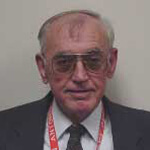
Millions who live with the bone-thinning disease osteoporosis lead fractured lives, and the disease is usually silent until the first break occurs.
But a new method patented this summer by radiology researchers from the Health Science Center promises to lead to earlier detection, giving patients more time to take medications to conserve their vanishing bones.
Robert Waggener, Ph.D., medical physicist at the Health Science Center, and Elizabeth Wieckowska, Ph.D., who wrote her doctoral dissertation while working in his lab, received a U.S. patent for “Three-Component X-Ray Bone Densitometry.” Dr. Waggener said it is an advance over existing bone density radiology, which distinguishes between bone and soft tissue but is not able to determine the fat and muscle content of the soft tissue. The inexact content analysis leaves room for some error with existing tests.
“There are good reasons why people sometimes wish to know the content of fat, muscle and bone,” Dr. Waggener said. “The bottom line is that being able to separate fat and muscle enables a more accurate estimate of bone density.”
In a bone densitometer, voltage is applied to a tube to produce X-rays. The X-rays generate a picture of the target field. Different voltages produce different energies of X-rays used to image different structures.
Existing technology applies two voltages to the tube to generate two X-ray energies; the new method applies three voltages to generate three energies. “Both the current method and our method use one tube, but the difference is that we apply a third voltage during examination of tissue,” Dr. Waggener said. “The instrument measures the X-ray photon energies transmitted through the tissue, and we apply mathematical analysis to the results.”
He said the new patent is based on a “subtle mathematical trick” that factors out noise from computation of results. Noise may be interpreted as any factor in an experiment that skews the result. Drs. Waggener and Wieckowska noticed a pattern to negative readings they were obtaining in densitometry experiments and were able to correlate the negative readings with the presence of fat. “We can do it in the lab, but now we are trying to transfer it to the clinic,” Dr. Waggener said.
The studies to date have been of bone, muscle and fat samples in the laboratory. Dr. Waggener hopes to develop a machine to examine humans within three years.

